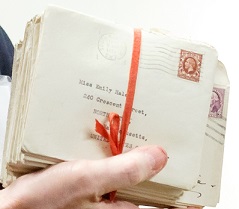The correspondence between T.S. Eliot and Emily Hale

The vagaries of love were on full display last week when Princeton University Library unveiled the largest trove of unpublished writings of the Nobel Prize-winning poet T.S. Eliot after a 50-year embargo.
The 1,131 letters were the gift of Emily Hale, a speech and drama teacher and talented amateur actress who, in a strange twist, that same day, January 2nd, was formally acknowledged by Eliot as the first woman he loved.
Eliot shocked his friends and family members — and Hale — when he married Vivienne Haigh-Wood, an impetuous Englishwoman, in 1915, after he left Harvard for what was to be a year-long fellowship at Oxford.
His marriage turned out to be a disaster, and in the 1920s, he resumed contact with Hale. The correspondence that she donated to Princeton covers the period from 1930 to 1956, shortly before he married his secretary, Valerie Fletcher, who was 38 years his junior.
A small gaggle of scholars, journalists, and this writer turned out at the Firestone Library on a wintry morning last week to get places in line for access to the letters. (My novel, The Poet’s Girl, based on what had been previously known about Hale’s life, was written in anticipation of this day.) The library staff had first opened the letters in October, 50 years after Hale’s death, as stipulated by her deed of gift, and began organizing them, making copies and preparing digitized versions.
Because of the restrictions of the Eliot estate, the letters can only be accessed at the library, and for the time being, cannot be duplicated or directly quoted. John Haffenden, now the editor of Eliot’s remaining letters, is working on a separate volume for these, but it is not clear when that will be published.
Hale donated the letters to Princeton because of her long friendship with Willard and Margaret Thorp; Willard was a longtime Princeton professor who founded its American Studies program, and his wife was a childhood friend of Hale’s and a scholar in her own right.
Hale clearly thought she had an obligation to future scholars — and to Eliot — to treat the letters reverently. A few years after she made her gift, she wrote him: “I do hope you will accept what is thrust upon us — shall we say — because you are you.”
But Eliot had an angry response to the news. Although it was reasonable for Princeton’s archivists to put the letters away in safe boxes and to arrange an appraisal for gift-tax purposes (something that seemed of no particular concern to Hale), Eliot said he felt as if he had been picked over by scavengers in the desert. (I would provide the exact quote here, but that letter is unpublished and thus would require approval of the Eliot estate to use.)
When Princeton prepared the “finding aid” for Hale’s letters, a delightful surprise was that the papers included a version of a short memoir she had written about her relationship with Eliot. She wrote:
“A strange story in many ways but found in many another life — public and less public than his. If this account will keep the prying and curiosity of future students from drawing false or sensational conclusions I am glad. After all, I accepted conditions as they were offered under the unnatural code which surrounded us, so that perhaps more sophisticated persons than I will not be surprised to learn the truth about us. At least, the biographers of the future will not see this ‘through a glass darkly’ but like all of life ‘face to face.’”
Knowing that Eliot had arranged for Hale’s letters to be destroyed, many of the researchers at Princeton wanted to start with her memoir, as it seemed to be the one place where we could learn her side of the story.
Moving on from that into Eliot’s letters, we found many expressions of love, devotion, and warm endearments — and true emotional caring, even after Eliot decided he could not bring himself to marry Hale after his first wife died in a mental institution in 1947. In her short memoir, Hale wrote that Eliot had told her that “Burnt Norton,” the poem that led me to her story in the first place, was his “love poem” to her.
Thus it was remarkable that, in midday on January 2nd, word went around the Special Collections reading room that Harvard’s Houghton Library had released a letter Eliot had written in 1960, with instructions that it be released the same day the Hale letters became public.
The whole tone of Eliot’s letter is somehow reminiscent of Bill Clinton’s “I did not have sexual relations with that woman” protests. Some observers felt the letter was likely written by Valerie Eliot, or that she put her husband up to it, knowing that she might still be alive when Hale’s letters were released. (Valerie died in 2012 at the age of 86.)
It is sad that, 50 years later, the Eliots decided the poet had to have “the last word.” What they could not have anticipated was that the letter would be released amid the #MeToo movement, providing yet another example of a powerful man trying to squelch the voice of a woman who was only trying to speak the truth.
[Photo courtesy of Princeton University Library.]
Sara Fitzgerald is a retired Washington Post editor and the author of the novel The Poet’s Girl.

